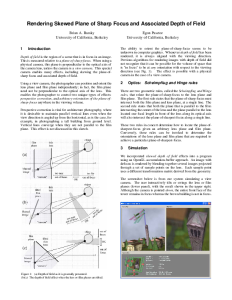Rendering Skewed Plane of Sharp Focus and Associated Depth of Field
Abstract
Depth of field is the region of a scene that is in focus in an image. This is measured relative to a plane-of-sharp focus. When using a physical camera, this plane is perpendicular to the optical axis of the camera lens, unless the camera is a view camera. This special camera enables many effects, including skewing the plane-of- sharp focus and associated depth of field. Using a view camera, the photographer can position and orient the lens plane and film plane independently; in fact, the film plane need not be perpendicular to the optical axis of the lens. This enables the photographer to control two unique types of effects: perspective correction, and arbitrary orientation of the plane-of- sharp-focus anywhere in the viewing volume. Perspective correction is vital for architecture photography, where it is desirable to maintain parallel vertical lines even when the view direction is angled up from the horizontal, as is the case, for example, in photographing a tall building from ground level. Vertical lines converge when they are not parallel to the film plane. This effect is not discussed in this sketch. The ability to orient the plane-of-sharp-focus seems to be unknown in computer graphics. Whenever depth of field has been rendered, it is always aligned with the viewing direction. Previous algorithms for rendering images with depth of field did not recognize that it can be possible for the volume of space that is "in focus" to be at any orientation with respect to the viewing direction (see Fig. 1). The effect is possible with a physical camera in the case of a view camera.
Citation
Brian A. Barsky and Egon Pasztor. "Rendering Skewed Plane of Sharp Focus and Associated Depth of Field". SIGGRAPH, 2004.









